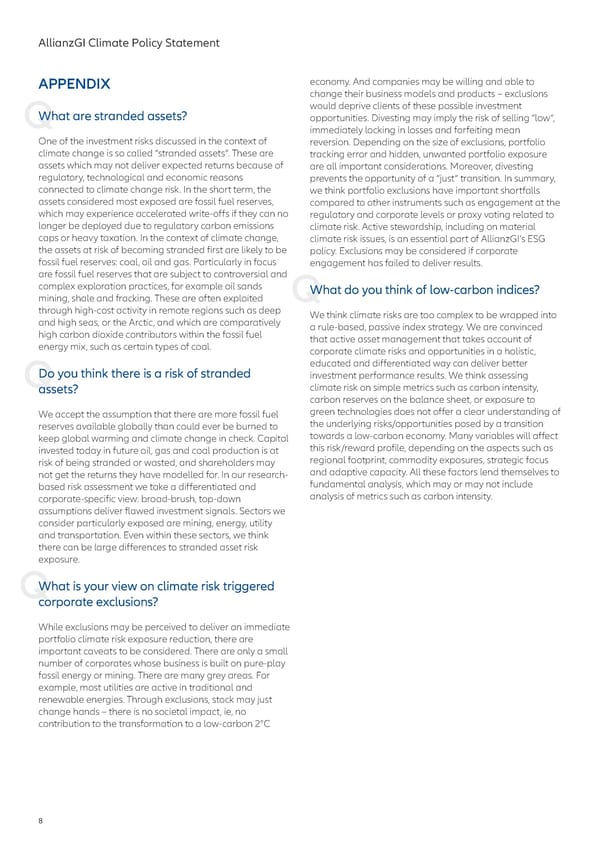Q Q Q Q APPENDIX What are stranded assets? One of the investment risks discussed in the context of climate change is so called “stranded assets”. These are assets which may not deliver expected returns because of regulatory, technological and economic reasons connected to climate change risk. In the short term, the assets considered most exposed are fossil fuel reserves, which may experience accelerated write-offs if they can no longer be deployed due to regulatory carbon emissions caps or heavy taxation. In the context of climate change, the assets at risk of becoming stranded first are likely to be fossil fuel reserves: coal, oil and gas. Particularly in focus are fossil fuel reserves that are subject to controversial and complex exploration practices, for example oil sands mining, shale and fracking. These are often exploited through high-cost activity in remote regions such as deep and high seas, or the Arctic, and which are comparatively high carbon dioxide contributors within the fossil fuel energy mix, such as certain types of coal. Do you think there is a risk of stranded assets? We accept the assumption that there are more fossil fuel reserves available globally than could ever be burned to keep global warming and climate change in check. Capital invested today in future oil, gas and coal production is at risk of being stranded or wasted, and shareholders may not get the returns they have modelled for. In our research- based risk assessment we take a differentiated and corporate-specific view: broad-brush, top-down assumptions deliver flawed investment signals. Sectors we consider particularly exposed are mining, energy, utility and transportation. Even within these sectors, we think there can be large differences to stranded asset risk exposure. What is your view on climate risk triggered corporate exclusions? While exclusions may be perceived to deliver an immediate portfolio climate risk exposure reduction, there are important caveats to be considered. There are only a small number of corporates whose business is built on pure-play fossil energy or mining. There are many grey areas. For example, most utilities are active in traditional and renewable energies. Through exclusions, stock may just change hands – there is no societal impact, ie, no contribution to the transformation to a low-carbon 2°C economy. And companies may be willing and able to change their business models and products – exclusions would deprive clients of these possible investment opportunities. Divesting may imply the risk of selling “low”, immediately locking in losses and forfeiting mean reversion. Depending on the size of exclusions, portfolio tracking error and hidden, unwanted portfolio exposure are all important considerations. Moreover, divesting prevents the opportunity of a “just” transition. In summary, we think portfolio exclusions have important shortfalls compared to other instruments such as engagement at the regulatory and corporate levels or proxy voting related to climate risk. Active stewardship, including on material climate risk issues, is an essential part of AllianzGI’s ESG policy. Exclusions may be considered if corporate engagement has failed to deliver results. What do you think of low-carbon indices? We think climate risks are too complex to be wrapped into a rule-based, passive index strategy. We are convinced that active asset management that takes account of corporate climate risks and opportunities in a holistic, educated and differentiated way can deliver better investment performance results. We think assessing climate risk on simple metrics such as carbon intensity, carbon reserves on the balance sheet, or exposure to green technologies does not offer a clear understanding of the underlying risks/opportunities posed by a transition towards a low-carbon economy. Many variables will affect this risk/reward profile, depending on the aspects such as regional footprint, commodity exposures, strategic focus and adaptive capacity. All these factors lend themselves to fundamental analysis, which may or may not include analysis of metrics such as carbon intensity. AllianzGI Climate Policy Statement 8
 Climate Policy Statement Page 7 Page 9
Climate Policy Statement Page 7 Page 9